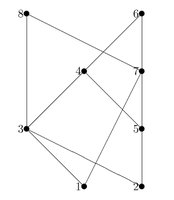Hello! I'm having troubles with one task from Formal Logic and Set Theory that may occur on an exam that I'm taking in just few days. I was given such Hasse Diagram:

I have to find Supremum and Infimum for every pair of points and I did that but I have troubles with some pairs. Mainly:
1) What is infimum for pairs (4, 7), (4, 8) and (6, 8)?
2) What is supremum for pairs (2, 1), (5, 1), (5, 3) and (7, 3)?
I marked sup / inf for all these points as non-existent, but I'm not quite sure about my answer. Can you please help me? I will be very grateful!

I have to find Supremum and Infimum for every pair of points and I did that but I have troubles with some pairs. Mainly:
1) What is infimum for pairs (4, 7), (4, 8) and (6, 8)?
2) What is supremum for pairs (2, 1), (5, 1), (5, 3) and (7, 3)?
I marked sup / inf for all these points as non-existent, but I'm not quite sure about my answer. Can you please help me? I will be very grateful!
